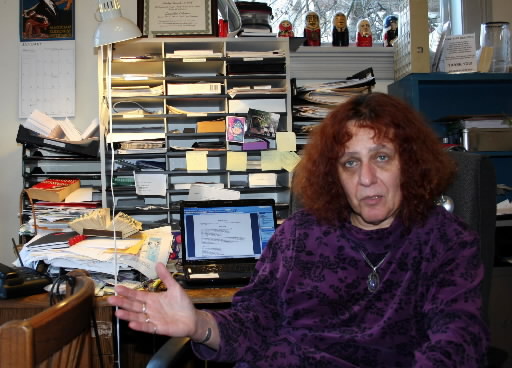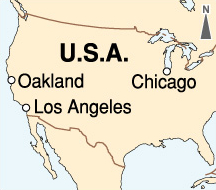Nuclear weapons can be eliminated: Chapter 1, Part 7
Mar. 18, 2009
Chapter 1: Superpower at a turning point
Part 7: From Hiroshima
by Yumi Kanazaki, Staff Writer
Grass roots movement arouses public opinion
Yuki Miyamoto, an assistant professor at DePaul University in President Obama’s hometown of Chicago, will never forget October 2, 2007: the day she feels certain Mr. Obama and Hiroshima became linked.
Ms. Miyamoto, 41, a native of Hiroshima, is the daughter of an atomic bomb survivor. On that day she was among a group of people preparing for an exhibition on the atomic bombing of Hiroshima to be held on campus one week later. They had just finished readying 50 photo panels when Mr. Obama, who was to give a speech on campus before the Democratic primary, suddenly appeared. He walked down the corridor, lined on both sides with photos, before entering the auditorium where he gave a speech in which he stated for the first time his determination to achieve a nuclear-free world.
It is believed that Mr. Obama intended to address the issue of U.S. nuclear weapons policy in his speech, so it is unclear what impact the photos of Hiroshima had on him. But Ms. Miyamoto noted that he spoke frankly about the issue despite the strong support for nuclear weapons in the U.S. “It was impressive,” she said recalling that day.
The display at DePaul University was part of an exhibition on the atomic bombing that has been traveling throughout the United States since September 2007. Sponsored by the Hiroshima Peace Culture Foundation, it is intended to arouse public opinion for the abolition of nuclear weapons in the nation which dropped the atomic bombs by holding exhibitions in all 50 states.
Shigeko Sasamori, 76, an A-bomb survivor who lives in a suburb of Los Angeles, said, “It’s wonderful that Obama saw the photos. The traveling exhibition will convey the horror of nuclear weapons to the American people and create support for Obama’s policies.”
In a homey office in downtown Oakland, across the bay from San Francisco, Jacqueline Cabasso, 57, greeted me with a smile. She is the North American coordinator for Mayors for Peace, of which Hiroshima Mayor Tadatoshi Akiba is president.
In addition to efforts to get more cities to join the organization, her role is to promote the “2020 Vision,” a movement advocated by the organization to bring about the abolition of nuclear weapons by 2020. She is collecting signatures on a petition in support of the adoption of the Hiroshima-Nagasaki Protocol at next year’s review conference of the Nuclear Non-proliferation Treaty. The protocol will pave the way to realization of the 2020 Vision. Ms. Cabosso is also lobbying the representatives of various countries.
As a result of her efforts to broaden support for the protocol, it has gained the support of the United States Conference of Mayors, to which the mayors of about 1,200 cities throughout the U.S. belong. At a symposium in Iowa in October 2008, the group emphasized that the use of nuclear weapons destroys the environment and called on mayors with an interest in the problem of global warming to support the cause.
Some people have said that cities should not be in the forefront of the nuclear weapons issue, which is regarded as a diplomatic and security matter, but Ms. Cabasso pledged to continue speaking out as part of her grass roots effort, saying, “Residents’ closest ties are with their cities. Speaking out at that level is highly significant.”
(Originally published on February 19, 2009)
To comment on this article, please click the link below. Comments will be moderated and posted in a timely fashion. Comments may also appear in the Chugoku Shimbun newspaper.









